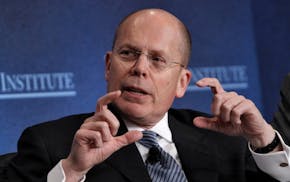Fairview provided official notice Monday that it doesn't want to extend its current partnership with the University of Minnesota beyond 2026.
The move potentially sets the stage for a high-profile breakup between the U and the health system. Fairview executives, however, cast the decision as a step toward a new academic medicine affiliation with the university while scrapping current financial terms that they believe are not sustainable.
This year, Fairview is providing at least $100 million in support for academic medicine at the university as part of a long-term agreement that runs just over three more years. Their affiliation is a key source of funding for training health professionals at the U.
"This step is not a statement about the future of a partnership with the University, rather that this current agreement cannot be what carries us into the future," Fairview's Chief Executive James Hereford said Monday in an email to employees. "To be clear: I see tremendous value for our patients and our community in a continued partnership with the University."
The current affiliation was set to automatically renew for another decade — which would begin in 2027 — unless either party gave notice by Dec. 31 of this year. Monday's action is Fairview's objection to that renewal.
The two entities have partnered since 2018 on M Health Fairview, which is one of the state's most prominent networks of hospitals and clinics.
The University of Minnesota said Monday its leaders previously stated they also believe the current affiliation needs to change.
"Fairview's announcement today simply reaffirms those statements," the U said in a statement. "Today's news does not affect the clinical partnership we have with Fairview today."
Even so, it's an important milestone in defining the future of the partnership, which is pivotal for the University of Minnesota's medical school — the program that trains about 70% of the state's physician workforce.
Monday's announcement doesn't change anything with current operations, Hereford said, and he stressed that the health system would "negotiate in good faith to reach a new agreement."
Fairview acquired the University of Minnesota Medical Center in Minneapolis in 1997 and combined its operations with the old Fairview Riverside hospital near the West Bank campus. The medical center complex now also includes a large outpatient clinic building on the East Bank as well as a pediatric hospital near the West Bank campus.
Ever since the acquisition, Fairview and the U have shared an academic health mission that spans patient care, medical research and training for health care professionals.
Over the past five years, however, Fairview has posted a series of operating losses. This financial red ink was subtext to the health system's proposed merger with South Dakota-based Sanford Health, first floated about a year ago.
The U opposed the combination as it would have shifted control of Minnesota's public teaching hospital to Sanford's headquarters in Sioux Falls. When the two health systems abandoned the proposed combination this summer, the focus turned to how the U and Fairview might salvage or restructure their fraught relationship.
In March, the Star Tribune reported how Fairview officials believed the 2018 affiliation agreement was directing more profits to the U than the health system, thereby contributing to Fairview's operating losses. University officials, in response, blasted "the depth of mismanagement" by Fairview's leadership.
Gov. Tim Walz this year convened a task force on the U's academic health program. Hereford said in his note to employees that he's scheduled to meet with the group Tuesday. Beyond addressing challenges, as well as chances for a new partnership, his message will also include "where I see opportunities for the State to support academic medicine," Hereford said.
The task force is deliberating over whether taxpayers, and other players across the health sector, need to provide more funding for the U's health care training programs. The group is also considering the university's argument that it needs greater control — or perhaps even ownership — of University of Minnesota Medical Center, which the U hopes to augment in the future with a new state-of-the-art facility.
For now, Hereford stressed that nothing changes for patients or workers.
"This step in no way impacts the delivery of patient care at our hospitals and clinics," he said in the e-mail. "We will continue to operate jointly as M Health Fairview through at least December 31, 2026, while we work to forge a new partnership with the University of Minnesota."

Prices for international flights drop as major airlines navigate choppy economic climate
Minnesota's med spa industry rises in popularity — and with little regulation

Hundreds line up at Best Buy to nab Nintendo Switch 2, in scene like '90s opening parties

